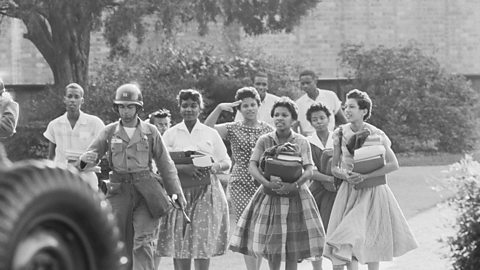Little Rock Central High School, 1957
After the Brown v Topeka decision, desegregationRemoval of laws that separate people from different races in public places and day-to-day life. was slowly implemented across the South. In Arkansas the superintendentA person who runs a school district in the USA. for the Little Rock School District, Virgil Blossom, came up with a plan to desegregate extremely slowly. His idea was to put more money into schools attended by black students. The aim was that black students and their parents would not find the newly desegregated schools as attractive, would choose not to apply to them, and that segregation would unofficially remain in place.
Blossomās plan was a compromise, allowing a small amount of integration, but it led to huge resistance. The governor of Arkansas, Orval Faubus, had promised in the 1957 election to stop desegregation. During the summer of 1957, he called for a delay to desegregation.
The first year at Central High School, Little Rock
Superintendent Blossom reduced the number of black students who were permitted to attend Little Rockās Central High School to only nine. However, Governor Faubus was determined to prevent any black students from attending the school at all. White people were demonstrating outside the school, and he claimed that this meant there was a threat to law and order. He ordered state troops to stop the nine black students from gaining entry to the school.
Nevertheless, eight of the students were escorted to the school by the president of the Arkansas division of the National Association for the Advancement of Colored People NAACPThe National Association for the Advancement of Colored People was created in 1909 to eliminate race-based discrimination across the United States of America., Daisy Bates. When they arrived, their entry was blocked by the troops. When they tried to enter the school a second time, they succeeded, but they then had to leave when the mob turned violent.
Many of these events, including white mobs threatening and using violence against black people, were broadcast by the national and international media. This level of attention forced President Dwight D Eisenhower to take action as the reputation of the USA was being harmed. When Governor Faubus ignored Eisenhowerās request to allow the students to attend, the president sent in federal troopsArmed forces controlled by the president in Washington, DC. and ordered the state troops to protect the black students, rather than block their entry. Three weeks after term started, the āLittle Rock Nineā were finally able to attend classes.

The nine black students spent much of their first year at Central High School in the media spotlight. They had soldiers to protect them for the entire academic year, but they still faced bullying and racist abuse from other students. Nevertheless, all but one of them stayed at the school for their first year. At that point, Ernest Green, the only one of the Little Rock Nine who was old enough, graduated from Central High.
Events after the first year at Central High School
After the events at Central High School, Governor Faubus was ordered by the US Supreme CourtThe ultimate court of appeal in the USA. It makes the final decision on whether a law is permitted by the US Constitution. to desegregate the other high schools in Little Rock. Faubus reacted by closing all the high schools in Little Rock in September 1958. White people with enough money to pay school fees, sent their children to a private school set up at the University of Arkansas. It looked like the integration of Little Rock had failed.
However, the concerns of less wealthy white people about the education of their children changed the policy. Schools were reopened and black students were readmitted. However, only a few black students attended Central High School, and some were placed in other schools. By 1972, schools were fully integrated in Little Rock.
Overall significance of Little Rock
The events at Little Rock had huge consequences, including:
- Other southern cities decided to continue desegregation slowly, so as to avoid stirring up dramatic protest.
- Some white parents began to move their children away from desegregated schools to the suburbs or private schools.
- The federal governmentThe central government in the USA, including the president, Congress and the Supreme Court. had shown that, where necessary, it was willing to overrule state governments.
The civil rights movement realised that winning legal battles was not enough. Media coverage was essential to bring about change.